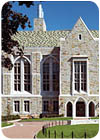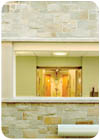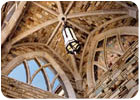
The 200-member firm of Shepley Bulfinch Richardson and Abbott, which is based in Boston, MA, uses natural stone in its work about 40 to 50% of the time. An example of this can be seen at Boston College, where the Gothic-style architecture features varying shades of rough-cut stone pieces.

The college's exterior stone facade was carried inside to its new atrium. “The whole atrium color scheme is derived from the color of the stone,†said Elizabeth “Zibby†Ericson, FAIA, of Shepley Bulfinch Richardson and Abbott. “That created a warmth and vital experience, visually. It is so integrated and so organic, that it is just beautiful.â€
After almost a century as a partnership, SBRA was incorporated in 1972. A Board of Directors, including four principals, supported by approximately 40 senior associates and associates, manages the firm, which is categorized into three primary practice areas - healthcare, education and science. As a full-service resource for its clients, SBRA supplements its core architectural, planning and interior design services with special expertise in historic preservation, restoration and renovation, and building envelope technology.
SBRA has been recognized with awards from leading client and design organizations for more than 100 years, and has been widely published in trade and consumer media throughout the world. In 1923, the firm - then known as Coolidge and Shattuck - won the First Harleston Parker Award, which was presented by the Boston Society of Architects and the City of Boston, for its design of the Boston Lying-In Hospital. Since then, SBRA has won this prestigious award three more times. In 1973, the American Institute of Architects bestowed its highest honor on SBRA, the AIA Architectural Firm Award.
Additionally, the firm has been honored with more than 50 design awards during the past decade. In 1997, SBRA was named one of America's best-managed firms in a survey by Architectural Record magazine. Members of SBRA take pride in upholding the strong tradition of their firm - building long-lasting relationships with clients and working with high-quality materials such as natural stone.
Recently, Contemporary Stone & Tile Design had the opportunity to speak with several members from Shepley Bulfinch Richardson and Abbott about their work, and in particular, their experiences with using natural stone. Participants included:
Elizabeth “Zibby†Ericson, FAIA, Principal, senior designer and member of the firm's Science Practice Group
Ralph Jackson, FAIA, Principal and senior designer for the Education and Science Practice group
Thomas Kearns, AIA, Principal, Chair, Education Practice Group

The exterior walls of the Paul Barret, Jr. Library at Rhodes College in Memphis, TN, are built from solid pieces of rubble stone, while Indiana limestone and Vermont slate were used for architectural details such as arches and window surrounds.
Kearns:We are a Boston-based firm with about 200 working all over the country and in Chile and the U.K. There's stone in all of those projects. We have a pretty broad reach, working in the areas of education, health and science. The firm also designs corporate and civic projects such as museums, public libraries and some courthouses.
Ericson:I think stone is in our minds. We use stone in our buildings about 40 or 50% of the time, especially for our academic clients who are also very interested in using stone.
Jackson:We are the oldest continuously practicing firm in the country. We therefore share a common legacy and history with many of our older institutional clients. They look to us as an office that will share their values, sense of quality and commitment. Stone is an intrinsic expression of their identity and legacy. The continued use of the material for the built fabric of their environment, over time, gives expression to their uniqueness. Stone, because of its cost, is a natural vehicle for conveying their commitment to place; their ability to renew without sacrificing values; and over time, the longevity of their service. For our academic clients who in some sense are building residential communities, the use of stone is not only a branding strategy, but a notion of community and intimacy, and its scale relative to the observer. When you are up close, you appreciate its texture, its color variation, the play of light across its surface, how it weathers. It evokes a sense of trust and belonging. Stone can give poetic expression to craft and the act of creating. Implicit in that is a community of builders. Stone is versatile in its emotional appeal; it can communicate a range of emotions, from authority to whimsy, and anywhere in between.
Ericson:I still would like to stress that stone has been in our firm's blood since the beginning. The incredible energy and character of these stone buildings, which have lasted all these years, are a great legacy. The challenge is to use stone in modern-day ways. We have a wonderful legacy, but it isn't about being retro to some style. It has to do with translating and continuing that energy and character.
CSTD:So how do you go about doing that?
Ericson:As Ralph said, you need to respect the academic campus fabric. If the granite is local, and they want it to look like the other buildings around it, then you need to respect that. At Boston College for Higgins Hall, I was told three times that I “wasn't Gothic enough.†I kept going back to be more Gothic, enriching the stone facade with arched openings and a tower entrance. Finally I was “Gothic enough.†Creating character is not always easy.
My challenge in designing hospitals is to use granite as a veneer and to create the energy between granite and other materials in composite facade design. At New England Deaconess Hospital in Boston, I conveyed such visual dynamism by threading white granite within brick elements, and by contrasting white and dark granite within a curtain wall system. The granite made the composition sing.
Jackson:When stone is functioning as part of a material palette at large, more urban-scale institutions, the mission of the institution creates a different response to the material. The institution's size, the constancy of change and speed of institutional evolution, cause industrialized construction techniques to replace craft concerns and the role of materials function differently. Stone, in this setting is seen as a veneer - a surface, a plane. Contemporary technology sees the building as a series of membranes. We constantly struggle to hide this characteristic, but realize stone gives volumetric identity, and if we want richer scale, it's illusory. Through mixing and juxtaposing colors, we can create graphic patterns and different compositional scales that visually enrich, humanize and ornament the building, but these are two dimensional strategies and patterns.
CSTD:What type of granite was used for the New England Deaconess Hospital project and others you have worked on?
Ericson:At Deaconess it was New York Lake Placid Blue and a more standard white [granite]. I remember getting enough of the Lake Placid Blue was a race with Mother Nature, because they were running out of blue and going into green at the quarry. So, it was exciting.
Jackson:At Rhodes College, the campus standard is an Arkansas Rubble Stone, which all comes from the same quarry, of which there were 2,200 tons. The stone is laid in the signature Rhodes random rubble pattern. Attention in the new library was paid to color variation, consisting of fluctuating shades of red and brown. The mason, W.A. Fortner Masonry, Inc. of Memphis, TN, installed the stonework for the last 10 buildings on campus. The decorative trim is limestone, and the roofs are covered in Vermont slate.
CSTD:Ralph, you had mentioned the craft of working with stone. What are some of the ways in which you can detail stone to show the craftsmanship and earthiness of the material?
Jackson:When the intricacies of the constructed wall become visually rich,,the wall metaphorically becomes synonymous with a textile in the richness of its pattern texture and color as well as in the way light interacts with it. We have given expression to the presence of the mind, the eye and the soul of the craftsman. In the case of the Paul Barret, Jr. Library at Rhodes College [in Memphis, TN], where the stone wall is mottled intentionally, you get to see the wall as a tradition of craft and a artisan's sculptural imprint. The Rhodes bonding pattern was emblematic of this quality. Poetically, the walls of the building feel timeless, indigenous, earthbound - as if they have always been there. Although scholastic in its intention, it feels primal in its earth tones.Kearns:That's where design and detailing in the stone industry are available to us. We work very closely with craftspeople. We always talk about what we are proposing, to see if it is feasible, if can we afford it, and how will it get done. There is quite a bit of support and knowledge in the stone industry that I'm not sure exists in every other area of the building industry. In the stone industry, in particular, there is such a long history and some great resources, and that helps you say to your clients - and also the contractors and construction managers-â€We've tested this and it's really feasible.â€
CSTD:Do you get this knowledge from the stone suppliers or the masons? Or is it a combination?

“In the case of the Paul Barret, Jr. Library at Rhodes College - where the stone has been mottled and you get to see the way it has been sculpted - you are able to see something that is unique about the material,†said Ralph Jackson, FAIA, of Shepley Bulfinch Richardson and Abbott.
Jackson:If you are working at an institution that builds regularly in stone, there is a culture that grows around the production. There is an inherent literacy in the community and the consultants, contractors and suppliers whom they hire around best practices, performance and quality. Naturally, a desire to return to those values sustains ones sense of quality.
CSTD:Do you go to the quarries often?
Ericson:We did for the New England Deaconess building for the Lake Placid Blue granite and for Boston College, which uses a local quarry.
Kearns:At Duke, there is an historic side and a more contemporary side, and within this materials palette, you can stretch to both of those extremes. The challenge is, “Can you create a vision that is fairly complex in terms of how you build something like that?†At the beginning of the project, the client can say, “This is what we are interested in,†and we say, “This is what we can get.†Then you ask yourself, “Can we really pull it off?†I think you need an integrated design process that brings together all the members of the team, including the people in the field and the people in the quarries, to figure it out.
CSTD:What is the process of specifying stone? Do you start with an idea of color or, maybe in the case of an institutional or educational project, you know from the beginning that you will use stone? Then, how does it progress that you are actually determining sizes, pieces and quantities?
Jackson:At the Rhodes campus, the stone was the palette of materials and the given ways of detailing. We were working on the library in association with another architect who had designed buildings for the college, but not buildings with this kind of program, so there were people on the project who were well educated in terms of the details and putting the building together. Our job was to come up with the compositional character. We were at an institution that had invested in this character and quality, and had the source for the stone and the contractors who had worked on the other buildings on campus. So we were able to maintain the quality and character of the library project because there was a community of people that solved the problem before.
Ericson:From my point of view, it depends. Boston College had its own stone quarry. Hence, there was no question what stone we would specify. It is a beautiful stone. It has greens, blacks and yellows in it. Boston College also had strong design opinions: we were to use a seven-stone lay up, and we were to hide any expansion joints, which is hard to do in a modern Gothic wall. The other extreme was New England Deaconess Hospital, where we had the luxury of looking at a range of colors from all over the country. It was a matter of looking at various types of stone and studying their relative smoothness, their shine, their textures and their colors - also what kind of pattern we wanted to have. The client sometimes tells you what you should use, and other times, you have a chance to negotiate.
Kearns:We are working now at Johns Hopkins University- a Georgian campus with Danby White [marble] trimmings. It's just fabulous. It's a beautiful campus with 14-foot-high Danby White columns. They are all so sensuous. The light comes from within. It's just an unbelievable material, but we can't do that anymore, which is fine, because it represents a challenge: “How do you create a new architecture that evokes the past, but reinterprets it?†We can't afford to approach those problems and opportunities in the exact same way that was done in the past and maybe we don't necessarily want to. So we found new ways to juxtapose marble and brick that connect to the past, but also create a new expression for the campus, which the community found energizing. That whole experience has been a good one.
CSTD:Do you find that your clients are sometimes hesitant to try something different?
Kearns:It's a process of working with them and testing and mocking up. It is also a matter of examining other materials. We had actually looked at the Danby product versus other white marbles as a possibility. We looked at marble from Georgia. It's a practical exercise.
Jackson:I think anyone who uses stone has strong feelings about appropriate use, and stone literacy, if you will, is largely based on historical precedent. New approaches require a particular kind of trust, an ambition to raise the bar aesthetically, a methodology for material experimentation, out of which exploration can grow. I've worked with clients who had a keen sense of the material and a particular stone that they wanted to use. When we designed the World Trade Center East Building, where our office is located, there was a strong desire on the part of the client to use a French limestone, which is highly variegated, in the lobby. The challenge for us was, “How could we create a detailing that tipped its hat to tradition, but was fundamentally contemporary, being more about color variation, planarity, light and sensual form; rather than neoclassical detailing?â€
CSTD:What degree of knowledge do your clients have regarding how natural stone can be used?
Kearns:We are a group of designers who focus on complex institutions with complex communities. These various groups all have a stake in the campus development, and all want to have a voice, so that discovery and negotiation are always an interesting part of our projects. Many of our clients have a sophisticated understanding of stone in regard to material selections, and others rely on us to educate them as to the merits of investing in quality materials.
Jackson:Typically our clients have a strong sense of the possibilities of stone in traditional uses and environments, from the point of view of precedent, as well as endurance. Rarely would they consider it a tool to give expression to innovation or change. Typically, our clients have a history of building and a preferred palette of materials.
CSTD:From a practical standpoint, do they understand costs?
Jackson:Our clients have a history of building and a preferred palette of materials, therefore, a clear sense of relative costs. Stone with certain institutions is considered a luxury material or one for special occasion or places. It is always nice to have the person holding the purse strings as an advocate.
The challenge is working with a client who hasn't built using the material historically or used it only as trim pieces. Postwar campuses that are celebrations of the construction technology of the period of brick or precast, or where limestone panels have been designed as if they were precast, are probably the most in hospitable to serious applications of stone.
Ericson:Within the constituencies, the facilities people - the ones who roll up their sleeves - are just as interested in the use of stone as any other institutional constituency, from both a maintenance and aesthetics point of view. They are as willing as the trustees to go out in the snow to look at a mock-up because it is just that important to them. I think, though, that the knowledge they have is different. The trustees will have knowledge regarding prestige and distinctiveness, and how the whole campus is going to be enhanced. The people in the facilities department may say, “You know, the seven-stone pattern wasn't the best. We've had a lot of trouble with that.†They give you hands-on feedback. It is a very rich spectrum of understanding and knowledge on the part of everyone involved, and you need to use all of it.

The design objective for Deaconess Hospital in Boston was to create a dynamic exterior with a combination of stone and brick.
Kearns:There is also an expectation that we are educating them, so we need to be sharing within our community - to have access to the innovations in this area so that we can bring that to our clients. “Are there innovations in quarrying that can help with cost?†We found that out at Duke. They changed the way they were quarrying, which brought down the cost, allowed us to use more of the product on the project, and improved the product quality.
CSTD:What have been some positive experiences of working with stone?
Ericson:At Boston College, the exterior stone of the original building became an inside facade when the building was expanded. The whole atrium color scheme is derived from the color of the stone, which created a warmth and vital experience, visually. The interior is so integrated and so organic, that it is just beautiful. I am particularly proud to bring the stone and other materials into harmony with color.
Jackson:Fordham University Library, Cornell University Law School, Tufts University Library and Rhodes College Library are all on campuses that are hospitable to stone. Location is the primary determinate for its use. Merging seamlessly with the existing pattern of use has always been the goal and very satisfying in each instance, whether creating a landmark at Rhodes or a background element at Cornell.
At the Tisch Library at Tufts University, the original lobby was all done in limestone. We were able to do an addition using granite. The original building was so poetic, but in one sense, it was like a mausoleum. We needed to open up the space. We were able to recycle the limestone from the existing building and make it an architectural ornament and then weave granite into that. So that became quite a powerful expression.
Kearns:Using stone on the interior at Duke and Illinois Wesleyann University provides an opportunity to bring a sense of quality and permanence to the inside of our buildings. We used it to frame openings and create beautiful thresholds. In some of our academic work where there are large zones of carpet, we try to define those spaces with a stone base, stone flooring materials and stone portals, which accentuate the sense of quality.
Jackson:When working with a client who is price sensitive, one of the areas that can guarantee you success in introducing stone is where there is going to be a maintenance issue. With the base of the building or the floor being stone in the public space, you are able to add both character and quality of the space, but also deal with the maintenance issue of foot traffic. That's a place where you can establish an identity, while serving a basic maintenance issue.
Ericson:From my point of view, I think the color of stone is what really makes it different from almost any other material. I like the idea that it is a unique contribution to the sense of architecture. There's just no substitution for it without losing something.
CSTD:On the other side, what have been some negative experiences that you have had working with stone?
Ericson:I had one. I specified Texas granite. It was pretty uniform and had a rich color. All of a sudden, one day, there were some little black spots on a couple of pieces of granite. Then the little black spots got a little bigger, and there were more of them. So finally, I went out to where all of the material was being shipped. They had hit some area in the quarry, and this black spot turned into a splotch. I told them that our specifications said that there could be no more than four spots on a piece, and that they could be no bigger than my thumb. It was really difficult because the stone had already been shipped from Texas. It was very difficult to negotiate, but our spec was pretty well written. That was a very hard experience, but it was long ago, and I learned from it.
CSTD:Did you have to sort the tile so that the most blemished pieces were spread out?
Ericson:No, we got new stone. Our spec was tight enough to say that stone they gave us was not acceptable. A mock-up also helps, because when the material is on the mock-up, you say, “This is what we approved, and this is what you are giving us. There is not much alignment here.†But that's one of the factors of working with any stone. You cannot control Mother Nature. You have to decide, “Can we make it beautiful anyway?†Stone is inherently beautiful, but sometimes you get what you hadn't counted on.
Kearns:I had a few accounts where I couldn't get control of the cost information in a way to close the deal, and get everyone to sign up. That happened [on a project] in Philadelphia, where we wanted limestone and couldn't quite get there for whatever reason. Maybe if there is a way to start to pool some of the knowledge and resources, it will help.